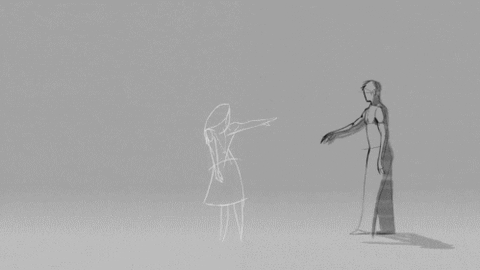Feel ... and Listen  [ Perception 101 ]
[ Perception 101 ]
Mindful embodiment of attention and emotional presence are learned skills.
author: Daniel Clary Webb, producer
According to me, one way to think about perception is to observe a fundamental difference between two modes we can all witness in ourselves:
-
Cognitive Knowledge
-
Felt-Sense Awareness
-
Cognitive Knowledge
This is where we "think things over" as an outsider. This is the domain of abstraction, analysis and value judgments. This is where we play out self-protective stories that tend to reduce our attention available for immediate sensations. When we're in a state of stress, it's natural for our energy to become focused impulsively on verbalization. Awareness of our sensations, where the real juice of our reality ("energy", "The Force") is flowing, can become eclipsed.
Unspoken verbal awareness — what I call "Yang perception"
When you're listening to your mind's Yang perceptions with your language centers, can you hear what your mind is saying ... to you ... or to an inside part of you ... or to an imagined other? Those messages are our bodymind's "stories" about our experience.
Yang perception is based on abstractions from our felt-sense experience. This happens when we're experiencing from outside an experience — "objectively" observing or analyzing or making value judgments.
Listening is not an internal, verbal activity. When our attention is fully on our conversation partner, we're felt-sensing, not verbalizing.
Listening with all of our attention is meeting someone where they are, not where we are. Felt-Sense Awareness
Let's bring some precision to our vocabulary as we consider sensations. It's common to speak of "the five senses" — visual, auditory, olfactory, gustatory and tactile experiences. What that leaves out is our sensations of joy, pain, visceral signals (like heartburn and heartache), and emotional responses. Our culture tells us we have five senses delivered to our brain from our eyes, ears, nose, mouth, and skin.
"The five senses" plus felt-sense sensations — what I call "Yin perception"
So where does that leave our more complex, felt-sense awareness? If our most salient word choices for these experiences are "touch" and "feelings", we may be leaving a blind spot around our more complex feeling states that don't fall neatly into the other categories.
Our felt-sense awareness is the way we feel connected to ourselves and to others. Felt-sense awareness brings us to the here and now. "Be here now" means to bring attention to our physical and emotional sensations — our felt-sense awareness.
When I was in my 20s and 30s, at times, intimates would say to me, "Daniel, get out of your head!" I wanted to learn what they meant by that. And I did. "Get out of your head!" was perhaps a less-than-charitable way of saying, "Please join me in the here and now to share a feeling of being connected." Bringing our attention to our felt-sense sensations here and now is the way we can be truly in relationship with another person. Internally verbalizing about an experience isolates us from others. That's what I was doing unconsciously when I was "in my head".
"The purpose of expressing feelings is to connect — to give the other person a window into our interior experience. Expressions of feelings can be like windows or like walls."
— Alan Rafael Seid, a collaborator on RapportTalk.com and someone I consider to be a wise man
Yin perception happens when we are experiencing a moment from inside a felt-sense of an experience.
RapportTalk provides tools to help you know how you feel and what you want in your current situation — not by the usual fill-in-the-blank approach, but by a multiple-choice approach.
Emotional responses are like an indicator on a car's dashboard. They tell us that something is happening that's worth focusing our attention on. Feelings (emotional responses) come from needs. If my need for trust is being met, I'm in a relatively uplifted state of mind. If not, my state may be profoundly affected.
The essence of emotional presence is being with your partner with your kind, felt-sense attention focused in the here and now — that is, to give as little attention as you can manage to the "stories" playing in your head when you're uncomfortable.
The primary value of the Return-to-Love Process™ is to hand you a situation-specific script at a troubled time. Enacting the script frees up attention from composing words, enabling you to listen to each other for a deeper experience of understanding and empathy — feeling what your partner feels from within their values and experience, and validating that.
To skip the mindfulness exercise below and go right to a situation and script, click here,
When we're in a difficult situation, we can notice how our attention tends to be pulled up into our internal narratives and conversations — our self-protective stories. Notice that we can direct our attention back to our felt-sense awareness whenever we want to. It's simple but not always easy. We simply have to intend to. Staying focused on sensations is a skill that can be learned and practiced. (I'm still looking for someone whose parents or school taught them this skill.)
Here's a recording of the guided tour of sensations below so you don't have to read while you do the exercise.
A felt-sense exercise
If you'll permit me to guide your attention for a few minutes, we'll have an experience together that liberates us from tensions and distractions, at least to some degree.
Let's sit together and visit with our breath for a couple of minutes — eyes closed or open. (You might want to try both.)
As you let your attention rest softly on your breath, it moves in a natural, automatic cycle. Can you feel your mind and body beginning to settle into a more peaceful state? There's no better or worse way to do this. You simply notice the already-happening sensations in your awareness, from moment to moment, with full acceptance — no preferences, no resistance, no ambitions or judgments about how you should be doing it better.
Are you willing to try an experiment with me? It's a guided tour of your sensations.
Notice the feeling of pressure wherever your body touches the chair and where your feet touch the floor.
Notice the pace and depth of your breathing. Just however it's already happening.
Notice the sensations in your hands and feet.
Notice the sensations in your face, neck and head.
Notice the sensations in your mouth and tongue.
Notice the sensations in your nose.
Notice the sensations in your throat.
Notice the sensations in your shoulders.
Notice the sensations in your chest and belly.
Notice the sensations in your arms and legs.
Notice the sensations in your back.
Notice the sensations in your eyes.
Notice the sensations in your ears, and hear the sounds around you.
Notice the sensations in your whole body as you breathe in and out. You might find this easier by slowly scanning your attention from one part of your body to another in sequence, or you might find it easier to simply rest your attention on all the sensations in your whole body, all at once.
Notice the pace and depth of your breathing. Just however it's already happening.
Notice the sensations in your hands and feet.
Notice the sensations in your face, neck and head.
Notice the sensations in your mouth and tongue.
Notice the sensations in your nose.
Notice the sensations in your throat.
Notice the sensations in your shoulders.
Notice the sensations in your chest and belly.
Notice the sensations in your arms and legs.
Notice the sensations in your back.
Notice the sensations in your eyes.
Notice the sensations in your ears, and hear the sounds around you.
Notice the sensations in your whole body as you breathe in and out. You might find this easier by slowly scanning your attention from one part of your body to another in sequence, or you might find it easier to simply rest your attention on all the sensations in your whole body, all at once.
Now notice that, if you bring to mind a difficult situation in your most significant relationship, you might feel how the discomfort of that situation tends to pull your focus onto internal storytelling, away from felt-sense awareness. Your mind starts talking to you, or it puts you in an imagined conversation with your partner (presumably to practice things to say and to see how you might feel after you said those things).
Now, with your intention, direct your focus again to the pace and depth of your breathing.
Can you feel the tug for attention onto "your story"?
Something wants you to attend to verbal actions and reactions.
As you rest your attention again on your breathing, can you feel a grounded reality of the felt-sense sensations in your body?
Which feels like a stronger tug?
Do you notice a tension between these intentions?
It's of no consequence whether you do or you don't. This is simply an awareness exercise.
Begin now to open your eyes to your immediate surroundings. We'll resume our conversation about self-awareness.
Self-awareness is being able to identify how you feel and what you want. When you're in your self-awareness, letting your mind be just as it already is, you're more "present". Your mind is less "noisy". You're more able to listen to your conversation partner and to be with them in their experience without value judgments about it — that is, internal vocalizations that categorize their experience as "good" or "bad". We've provided a tool to help you know how you feel and what you want in your current situation — not by the usual fill-in-the-blank approach, but by a multiple-choice approach.
For assistance in knowing how you feel in your current situation, go here.
For assistance in knowing what you want in your current situation, go here.
By enacting the Return-to-Love Process™ scripts, you're practicing the art of emotional intelligence, successfully. This is a learn-by-doing process, not an academic exercise.
So, welcome to our world! Reviving relationships through collaborative conversations and mindful presence is our thing. You belong here. (Stand by to be amazed.)
A true story about a scripted conversation that changed everything
Describe your troubling situation and get a kind script to help resolve it.



